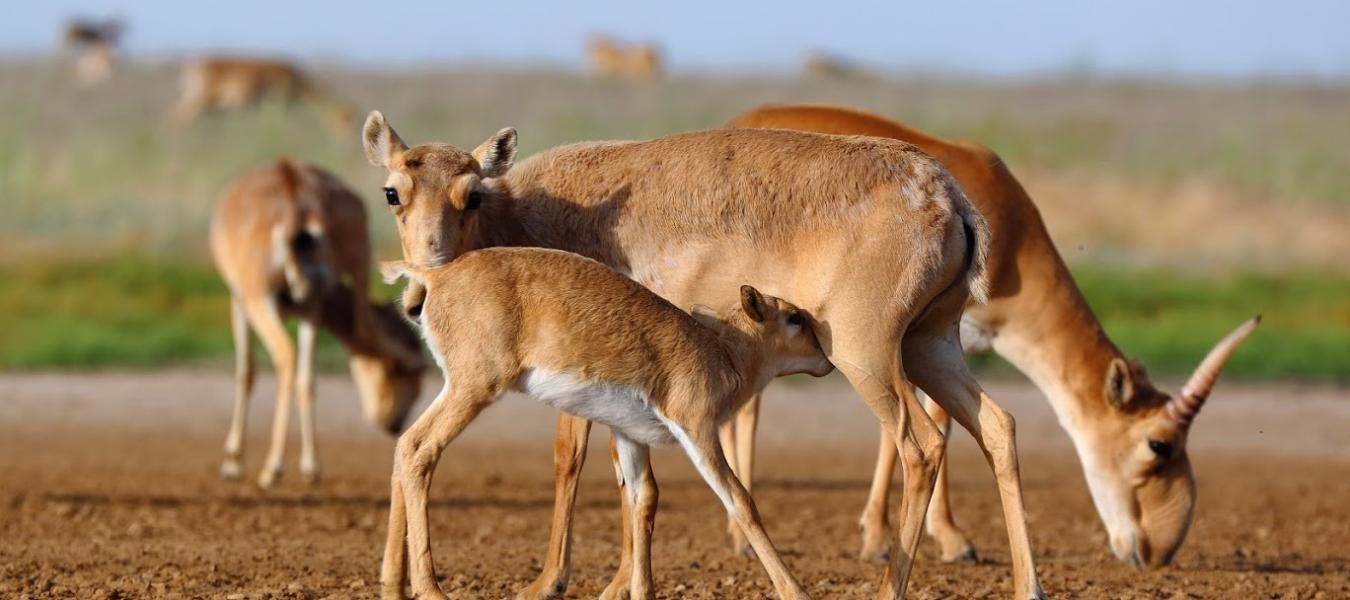
Spring in the Stepnoi Wildlife Sanctuary
Vladimir Kalmykov1, Maria Vorontsova2
1 Stepnoi» Sanctuary, limstepnoi@mail.ru; 2 Russian Branch of the International Fund for Animal Welfare, IFAW, mvorontsova@ifaw.org
It is spring. The steppe begins quickly to grow green and some places turns into a flower garden. Birds are returning to their homeland and the steppe is suffused with their chirrups. But the most important thing is that the time is nearing when baby saigas will arrive in the Stepnoi Sanctuary. This will be 16th calving at the reserve and the Sanctuary staff are preparing for it with particular care.
The 54,000 hectares of the officially designated Saiga Reproduction Zone is where saigas come in May each year. So as to ensure tranquility at this very challenging time, and in compliance with instructions from the Nature Management and Environmental Conservation Service of the Astrakhan region, movement is restricted on all the roads running through the Reproduction Zone and signs have been posted informing drivers of the temporary closure. A feeling of anticipation for the miracle of new lives coming into this world has descended in the Sanctuary and it seems that everything is ready for calving. But in the end the saigas could not find that small piece of the Astrakhan steppes where baby saigas come into being. It was the weather that complicated the situation. Even elderly residents could not recollect similar weather; hurricane-strength winds, very heavy downpours making the steppe roads resemble Venetian canals, huge flooded plains - all these scared both the saigas and people, who stopped dead in anxious expectation.
In spite of everything, the saigas at last selected two places located about 20 km apart. By eye, about 2500 females gathered for calving and apparently were waiting for the weather to improve. And at last, on May 18th, a sun as bright and hot as in the summer and a light wind began quickly to dry the soil and the emerald-silver feather-grass. In the afternoon, the steppe filled with the distinctive sounds of new-born baby saigas shouting to their mothers.
This year the team decided to prevent any disturbance, even for scientific purposes. Calving lasted just a week, and the death rate of females and newborns appeared very low. We observed the behavior of the vultures, which regularly fly into the calving grounds from far away. This time they had to satisfy themselves mainly by eating placentas. So we have hopes for a good population increase in 2016.
Life is pulsing in the Sanctuary: fox cubs, wolves and hares are gambolling around; bird of prey fledglings are growing up in their nests while young cranes are slowly waddling after their parents. And all these in the midst of the still-brilliant green blooming steppe. The steppe idyll! Yet rather soon this pleasing picture will be replaced by a more severe landscape; the multicolored spring carpet will turn into a yellow, hard surface that heralds the forthcoming season of wildfires - both natural (for instance, caused by a dry thunder-storm) and man-made. In order to minimize the losses from fire the staff sanctuary cleared the roads and ploughed up the especially hazardous places. This work was possible thanks to financing from the Nature Management and Environmental Conservation Service of the Astrakhan region along with support from the Russian Branch of the International Fund for Animal Welfare (IFAW). It is also difficult to overestimate the assistance in prevention and extinguishing of fires which from local farmers, with whom the sanctuary staff have recently established friendly relations based on a love of nature and their native land, as well as mutual assistance and understanding. We are sure that together we will be able to defend the inhabitants of our sanctuary.
In conclusion, we would like to express our great gratitude to the Nature Management and Environmental Conservation Service of the Astrakhan region for their continued attention to the sanctuary as well as to our colleagues and partners who have helped us to do so much this year. Thanks to the Saiga Conservation Alliance, we managed to fit out a small station in the sanctuary where our rangers can rest. Thanks to IFAW, the ranger station has been equipped with a solar battery so we have light and power. Thanks to the funds raised by WWF-Russia, we didn't run out of petrol. What else… This year our long-standing dream has come true; IFAW presented the sanctuary with two camera traps which will help us to record hidden events (especially after dark): https://www.instagram.com/p/BHR67cIASBC/.
In spring and early summer of 2016, we were happy to host research scientists from Saint-Petersburg University and the Institute of Ecology and Evolution of the Russian Academy of Sciences, a group of cameramen from the UK
More info here and Here, as well as members of the Caucasus Regional Branch of WWF-Russia, and eco-tourists from Volgograd see here
We always welcome those who visit us with good intentions!
And finally: all the members of our small staff work with their hearts and souls and, using today's vogue word, are "results-orientated"! Our expected result is to help saigas survive in the unfavorable conditions of the north-west pre-Caspian region and do our utmost to conserve this species for future generations.
